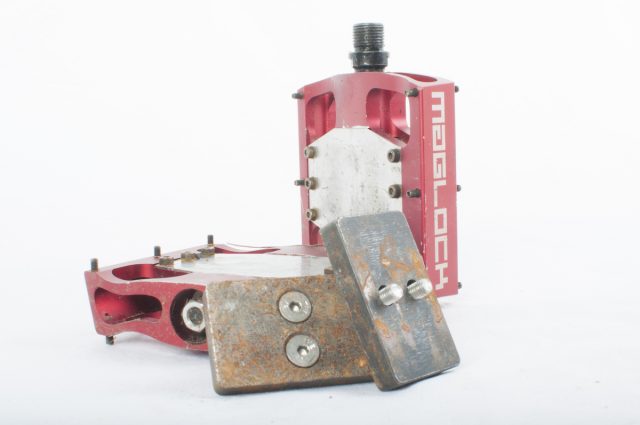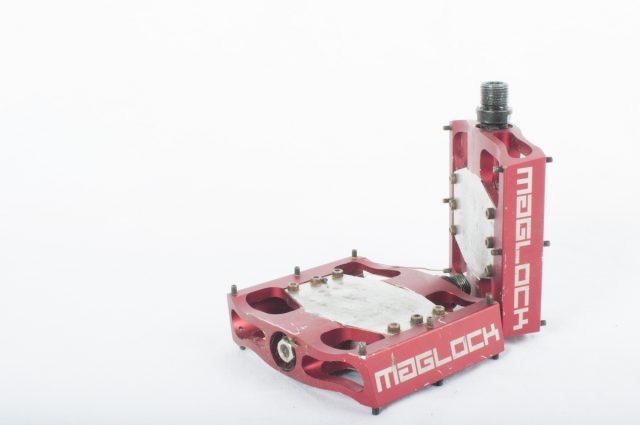Rewind to issue #104 of Singletrack Magazine where we put the MagLOCK Bike Pedals to the test.
These intriguing pedals came from a Kickstarter campaign which raised nearly $40,000, and are basically flats with big magnets in them, plus ferrous cleats. The idea is that, for those nervous of clipping in, they’re much easier to unclip from than an SPD. That’s true, though it comes at the cost of feel.
Living somewhere rocky and steep has imparted a tenacious riding style that glues my feet down to almost any flat pedals, even when rocks have shaved half the pins off. These MagLOCKs have really hit home just how much information I take in through my feet, unfortunately by eliminating it.
The pedal construction is, I’m sad to say, not good. A pair weighs almost a kilogram, which is very noticeable on the bike. The bodies are fat and run on bushings with no bearings. There’s a lot of play between axles and the bushings, and with no end caps or seals, gack can just fire itself in there.
The cleats are blocks of steel with SPD holes. They mate with flat stainless steel plates on each pedal, under which sits the rare-earth magnet array. With the few inches of leverage a shoe provides, it’s very easy to remove the cleats from the pedals. I wouldn’t reduce the number of magnets, though you can.
While technically true, their claim of “works with any SPD shoe” bends the definition of ‘works’. Each side only has six pins, and while they’re not short they are far apart. The first shoes I borrowed made no pin contact. A terrifying car park spin felt like having pedals made of ice, so I threw them back in the van. Eventually I sniffed out a pair of flatter soles, but even so only the back pins made contact.
Attempting bunny hops I found my feet leaving the pedals, or the bike listing. Cursing my sloppy technique, it didn’t occur to me at the time that these things don’t normally happen. I set off and, without really noticing, started to feel angry. I was on a bike that I love to bits, but it had stopped talking to me.
For ratchety technical climbs the infinite float was counterproductive as there’s nothing (apart from the pull of the magnets) to keep your foot from wandering around, or even completely off, the pedal. Heading down, even trying my hardest to be smooth, every third time or so off the ground would result in unclipping. Drops I’d normally fly off gave me second thoughts: I felt muzzled. After three hours I thought I’d got the knack, then hopped a water bar and my right leg shot into space.
Infinite float means your foot can slide and roll. It takes very little force to unclip, sometimes accidentally. Combined, these things seem to send my proprioception haywire; the rest of my body responds as if the bike is doing something it’s not, then I land skew-whiff or slide gracelessly into a mossy bank. The feedback I’d normally get through flat pedals is almost completely missing.
Overall
MagLOCKs made my bike feel numb, and every use case I can think of for them is narrow. There are certain types of injury they’re probably great for, but for most riders, I’d say SPDs or regular flats are both better options.
Wanna see what MagLOCK’s story is with these pedals? Check out their Kickstarter video from last year;
Review Info
| Brand: | MagLOCK |
| Product: | Bike Pedals |
| From: | MagLOCK |
| Price: | $164.99 USD (£124.38) |
| Tested: | by David Hayward for two months |
Comments (0)
Leave Reply
Post Comment




I’m somewhat staggered anyone looked at these on kick-started and thought the result would be anything other than exactly as described above.
I’m guessing the $40k came mainly from people who’ve never ridden proper clipless pedals before!
OTOH they’re really handy for finding a dropped snaplink in long grass 😀